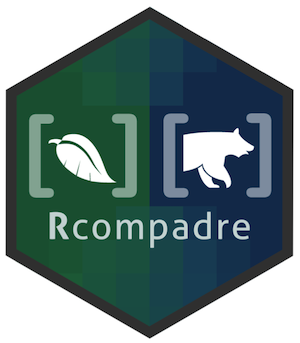| Project | Main branch | Devel branch |
|---|---|---|
 |
||
An R package to facilitate working with the COM(P)ADRE Plant and Animal Matrix Population Databases.
Installation
Install the stable release package from CRAN with:
install.packages("Rcompadre")Install the package from GitHub with:
# install package 'remotes' if necessary
# will already be installed if 'devtools' is installed
install.packages("remotes")
# argument 'build_opts = NULL' only needed if you want to build vignettes
remotes::install_github("jonesor/Rcompadre", build_opts = NULL)To install from the development branch use:
remotes::install_github("jonesor/Rcompadre", ref = "devel")Usage
Fetching a database
Fetch the most recent database version from compadre-db.org with
compadre <- cdb_fetch("compadre") # or use 'comadre' for the animal databaseor load from a local .RData file with
compadre <- cdb_fetch("path/to/file/COMPADRE_v.4.0.1.RData")If you prefer using load() to load your local copy of a legacy database, use as_cdb() to convert it to the CompadreDB class
Subsetting
For the most part CompadreDB objects work like a data frame. They can be subset using [, subset() or filter()
Example analysis: calculating population growth rates
First we’ll use the function cdb_flag() to add columns to the database flagging potential issues with the projection matrices, such as missing values, or matrices that don’t meet assumptions like ergodicity, irreducibility, or primitivity.
compadre_flags <- cdb_flag(compadre)We’ll only be able to calculate population growth rates from matrices that don’t contain missing values, and we only want to use matrices that meet the assumption of ergodicity, so we’ll subset the database accordingly.
compadre_sub <- subset(
compadre_flags,
check_NA_A == FALSE & check_ergodic == TRUE
)Finally, we’ll use the eigs() function from the popdemo package to calculate the population growth rate for every matrix in compadre_sub.
In the code above, the accessor function matA() is used to extract a list of projection matrices (the full matrix, matA) from every row of compadre_sub. There are also accessor functions for the matrix subcomponents (matU(), matF(), matC()), and for many other parts of the database too.
Previous releases
Specific earlier releases of this package can be installed using the appropriate @ tag.
For example to install version 0.1.0:
remotes::install_github("jonesor/Rcompadre@v0.1.0")See the Changelog for more details.
Citation
Jones, Owen R., Patrick Barks, Iain M. Stott, Tamora D. James, Sam C. Levin, William K. Petry, Pol Capdevila, et al. 2022. “Rcompadre and Rage – Two R Packages to Facilitate the Use of the COMPADRE and COMADRE Databases and Calculation of Life History Traits from Matrix Population Models.” Methods in Ecology and Evolution. doi: 10.1111/2041-210X.13792.
Contributions
All contributions are welcome. Please note that this project is released with a Contributor Code of Conduct. By participating in this project you agree to abide by its terms.
There are numerous ways of contributing.
You can submit bug reports, suggestions etc. by opening an issue.
You can copy or fork the repository, make your own code edits and then send us a pull request. Here’s how to do that.
You can get to know us and join as a collaborator on the main repository.
You are also welcome to email us.
